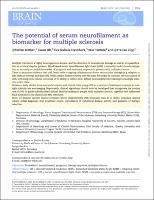The potential of serum neurofilament as biomarker for multiple sclerosis
Date
2021-10Permanent link
https://hdl.handle.net/11351/7631DOI
10.1093/brain/awab241
ISSN
1460-2156
WOS
000733375400012
PMID
34180982
Abstract
Multiple sclerosis is a highly heterogeneous disease, and the detection of neuroaxonal damage as well as its quantification is a critical step for patients. Blood-based serum neurofilament light chain (sNfL) is currently under close investigation as an easily accessible biomarker of prognosis and treatment response in patients with multiple sclerosis. There is abundant evidence that sNfL levels reflect ongoing inflammatory-driven neuroaxonal damage (e.g. relapses or MRI disease activity) and that sNfL levels predict disease activity over the next few years. In contrast, the association of sNfL with long-term clinical outcomes or its ability to reflect slow, diffuse neurodegenerative damage in multiple sclerosis is less clear. However, early results from real-world cohorts and clinical trials using sNfL as a marker of treatment response in multiple sclerosis are encouraging. Importantly, clinical algorithms should now be developed that incorporate the routine use of sNfL to guide individualized clinical decision-making in people with multiple sclerosis, together with additional fluid biomarkers and clinical and MRI measures. Here, we propose specific clinical scenarios where implementing sNfL measures may be of utility, including, among others: initial diagnosis, first treatment choice, surveillance of subclinical disease activity and guidance of therapy selection.
Keywords
Biomarkers; Neurofilament; Therapy responseBibliographic citation
Bittner S, Oh J, Kubala Havrdová E, Tintoré M, Zipp F. The potential of serum neurofilament as biomarker for multiple sclerosis. Brain. 2021 Oct;144(10):2954–63.
Audience
Professionals
This item appears in following collections
- CEMCAT - Articles científics [161]
- HVH - Articles científics [4471]
The following license files are associated with this item:

 Private area
Private area Contact Us
Contact Us








